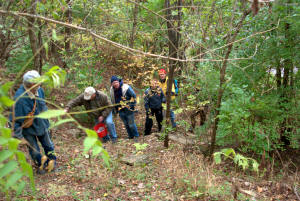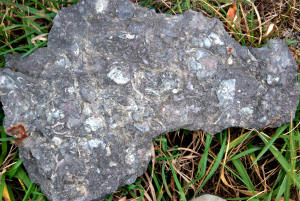
The Dry Dredgers returned to a site last visited in March 2012. It is a huge road cut that exposes much of the Latonia (Kope), Fairview and Bellevue Formations.
It was late October. The morning was chilly and windy but the sun was out most of the time and we began working on the sunny side of the road cut.
We always have some kind of super hero show up for the October
field trips because it's close to Halloween. Last year it was
Bob Bross as Batman. This year it's SUPER RON!
Shown below he is about to launch himself into the upper strata. When super
heros show up, there are plenty of photo opportunities. Super Ron did not reveal
his true identity until later in the day when it became too warm for the mask.


Did I say that site is huge? Here is a picture of the road
cut. Look how small Super Ron looks as he jumped from shelf to shelf. Maybe he
will find another Godzillus fossil!


Meanwhile the Earth-bound Dry Dredgers enjoyed collecting
Fairview fossils from the lower shelves.


These members are looking in the layer of the Fairview
formation, rich in
the unusual brachiopod, Strophomena
maysvillensis. Shown below, the layer is chunk full of these
broken brachiopods. The trick is to find a complete specimen.





Unless you are Super Ron, the highest shelves were reached by
climbing the gentle wooded slope at one end of the cut. Here, we found fossils
of the Bellevue Formation.

The view from up here was fantastic, as you can see in these photos.
Some of the Fossils We Found That Day
Trilobites
Perhaps the best find of the day was this partial trilobite
Isotelus gigas. Pictured below, it has the complete
pygidium and 5 of the 8 thorax segments. Nice find Lowell!
Picture and specimen courtesy of Lowell Hobbs.
As far as I know, only one Flexicalymene meeki was found. This
one is prone which makes it very susceptible to weathering away if it sits on
the surface too long. Lowell rescued this one before it was completely gone.
Picture and specimen courtesy of Lowell Hobbs.
Ichnofossils
One of the most common fossil types found on this site were
traces of worms and other animals burrowing in the mud. This first photo is of
two animals who passed each other at different moments. When Super Ron
presented me with this specimen to photograph, he said 'The fossils are
talking to us. "X marks the spot."' He was then gone in a flash before
I could thank him.

The worm burrows below are Diplocriterion.


Bryozoans
Ramose (branching) bryozoans come in all shapes and sizes. (next 2 pics)
Trepostome Bryozoans
The Maysvillian Stage of the Cincinnatian is loaded with encrusting bryozoans that blanketed the bottom of the Ordovician seas on some spots. These bryozoans can be small patches on other fossils or massive structures. Identification of the specific genera usually requires thin-sections to be taken and examined. Here are some photos of these types of bryozoans found that day.
Above picture and specimen courtesy of Lowell
Hobbs.
On this site was found evidence of a bryozoan reef. Like coral
reefs which occured much later, Ordovician bryozoans developed massive
structures. In this case, they were groups of mounds consisting mostly of the
mound builder Stigmatella personata . Here are some of the bryozoan specimens from these mounds found that
day.
The above close-up shows borings, named Trypanites, in the bryozoan surface.
Here is the back side of this bryozoan specimen.

Thanks very much to David Calhoun who generously dragged these big specimens down the long hill for me.
WEBMASTER UPDATED NOV 2014: These Stigmatella personata byozoan reef mound fossils are now deposited in the Cincinnati Museum Center's Geier Collections. Paleontology benefits from our important fossil finds when we donate them to museum collections.
One of the most common bryozoans found in the Fairview layers of this site was Constellaria florida. (next 6 pics)

Above picture and specimen courtesy of Lowell
Hobbs.
Brachiopods
In the layers of the Fairview formation, we found the
brachiopod Plectorthis sp.
In the picture below, the Plectorthis is indicated
with a red arrow. The larger similar brachiopod in the upper left part of the
slab may be an uncommon brachiopod still being investigated by Steve Felton.
A more common brachiopod we found was
Zygospira modesta,
seen in quantity on this rock.
A much larger brachiopod that can be found not only on this
site but almost everywhere in the Cincinnatian Series above the Kope formation
is Rafinesquina sp.. (below
- brachial and pedicle valves.)
In some cases, brachiopods were encased in matrix. When the
rock is broken open, it reveals beautiful calcite crystals formed in the
now-vacant interior of the brachiopod.
Now come the inarticulate brachiopods. Many of these attached
themselves to other surfaces such as articulate brachipods. Here is a nice
example of what I think are to
Schizocrania filosa clinging to a Rafinesquina
sp.. This was a good find, as Schizocrania
are not very common.
A more common inarticulate brachiopod we found was Petrocrania
scabiosa. (next 2 pics)
Nautiloid Cephalopods
Here's an excellent example of a straight-shelled nautiloid
cephalopod with the ciphuncle exposed. This siphuncle has slightly diagonal
lines across it.
Picture and specimen courtesy of Lowell Hobbs.
Even more interesting is the cephalopod specimen below. It has
longitudinal lines that appear to be surface features usually lost in internal
molds.
Above 2 pictures and specimen courtesy of Lowell Hobbs.
This next cephalopod specimen is more the typical preservation - internal molds of chambers.
But occasionally you get a cephalopod with some brown calcite
preservation. (below)
Other times we found the indentation the cephalopod shell left
in the surface of the rock. This rock, when flipped over, reveals negative
in-fills of burrows. 

This last cephalopod is hard to see in the rock surface.
Mostly this is problem with the photographer (me) and not the fossil.

Gastropods
There were quite a few gastropods of the genus Cyclonema on
this site. This first picture is one identified by Steve Felton as
Cyclonema humerosum.
The next 2 I'm not sure of the species, but we can call them
Cyclonema sp.. The "sp." indicates that the species is
not specified.
Most of the gastropods we found were nothing more than
internal molds, such as the one below. In these cases, the genera can not be
accurately determined unless features of the internal surfaces are visible.

Pelecypods
A number of examples of the bivalve Caritodens sp.
were found that day.
Crinoids
No crinoid calyxes were found that day as far as I know. Stems
were easily found loose on the ground and on the surface of rocks (next 2 pics).

Others
One thing to point out is that this site was completely loaded
with fossils. Most are in poor condition and/or not easy to collect, such as
when they are cemented inside rock. Here is one example showing lots of
different types of animal hard parts preserved on one rock.

Now let's see more photos of this trip from Ron Fine.
See more photos of this trip from John Morawetz.
That's all for this trip. Hope you enjoyed it.
Now let's see our rainy March 2014 field trip to Southeast Indiana
See some of our previous trips to this site.
March 2012
September 2009
March, 2008
September 2005
April 2005
Sept. 2003
Back to the Field Trip Index Page
Return to Dry Dredgers Home Page
The Dry Dredgers and individual contributors reserve the
rights to all information, images, and content presented here. Permission to
reproduce in any fashion, must be requested in writing to admin@drydredgers.org.
www.drydredgers.org is designed and maintained by Bill Heimbrock.